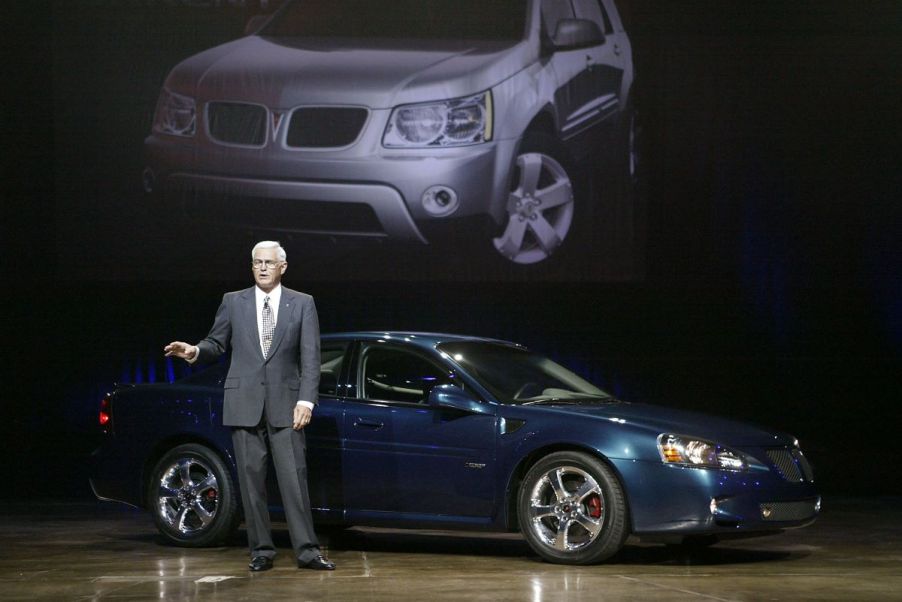
Pontiac Grand Prix GXP: GM’s Weirdly Innovative Pre-Recession Moonshot
Many have forgotten, but before General Motors (GM) declared Chapter 11, Pontiac was its sporty brand. It placed above Chevrolet in the subsidiaries, and as one of Detroit’s more exciting marques, it liked to take risks. In the last generation of their long-lived Grand Prix, they decided to make a front-wheel drive sports sedan stocked with an LS4 V8. GM engineers touted the resulting Pontiac Grand Prix GXP as one that could run with European sports cars.
When did the Pontiac Grand Prix GXP come out?
Following the 2004 redesign, the eighth-generation Grand Prix was built on GM’s W platform. The front-wheel drive forum underpinned multiple Buick, Chevrolet, Pontiac, and Oldsmobile offerings. The trim levels were the GT with the naturally-aspirated 3.8-liter V6, the GTP adding a supercharger, and the GXP hosting a V8.
The top-tier Pontiac Grand Prix GXP was the most performance-minded of the bunch. Underneath, a sport-tuned suspension featured Bilstein gas-charged struts, sitting the car about half an inch lower. The StabiliTrak dynamic control system operated traction, and Magnasteer II allowed variable speed control maneuvering. For instance, maximum assistance is available from power steering in low-speed conditions, whereas it backs off at higher speeds.
Aggressive bodywork makes the GXP stand out from the lineup. Touches include wheel well cooling vents to disperse heat from the slotted rotors and cross-drilled brakes.
Is the Pontiac Grand Prix GXP front-wheel drive?
One of the most significant innovations of the Pontiac Grand Prix GXP is its different-sized wheels and tires on the front and back. The 18-inch Alcoa forged aluminum wheels had an 8-inch width in the front and a 7-inch width in the back. Why was this the case? The Pontiac Grand Prix GXP, despite its rear-drive-derived 5.3-liter V8, was front-wheel drive.
Putting 303 horsepower through the front wheels is a tough task. Even more challenging was shoving a V8 into an engine bay designed for a transversely-mounted V6. To solve the packaging problem, GM engineers took the LS3, shorted the crankshaft, relocated that water pump, and went to a single serpentine belt. Then they mounted the V8 transversely, like GM products with the Northstar engine.
However, having the front wheels put down the power and steer presents another problem. Worse than the issue of understeer in a car with a 64-36 weight distribution was torque steer. For example, hitting the accelerator pedal will make the car dart eighter left or right and not straight. To counter the unfortunate physics, the Pontiac Grand Prix GXP had Bridgestone custom make 255/45 tires for the front and 225/50 for the rear, Car and Driver says.
How did it drive?
“We wanted a car to run with BMWs,” said then-program engineering manager Phil Minch, who would later help design the mid-engine C8 Corvette. So, how did the innovative drivetrain work out? Reviewers said the GXP cornered and handled well. But that may be based on pre-conceived notions, not comparisons with benchmark Bavarian sports sedans.
Even though GM put countless hours of engineering work into the handling, there’s still mild understeer. Yet, it’s sorted out enough to achieve 0.82 g on the skidpad, which is displayed on the head-up display g-meter. However, lateral acceleration can only be viewed when stopped, meaning liability-concerned Motown lawyers got a peek before it went on sale.
The inventive paddle-controlled TAPshift manumatic gearbox gave drivers a more engaging feel. But since it’s a four-speed unit in a big car with a wide torque band, it’s pretty unnecessary. Moreover, it’s fairly fragile. But Shooting Cars says folks swap it for the four-speed in the Pontiac Bonneville, which has an equally feeble Northstar V8.
How many Pontiac Grand Prix GXPs did GM make?

Over five model years, less than 18,000 Pontiac Grand Prix GXPs were made, Jerry reports. So, it’s not as rare as one may think. Regrettably, it would never endure a facelift or a redesign. The Grand Prix was pulled from Pontiac’s lineup in 2008, two years before the brand was dissolved as part of GM’s Chapter 11 reorganization.
Ultimately, the Pontiac Grand Prix GXP was a moonshot to show off how clever GM could be. Unfortunately, the problems they solved to make a comfortable, exciting, well-equipped sports sedan were primarily self-imposed. There were more quirks and desirable features. For example, the GXP didn’t come with a spare tire—only Fix-a-flat and an inflator—presumably because of the different tire sizes. Nevertheless, it can still be appreciated as the most entertaining sedan Pontiac ever made.


